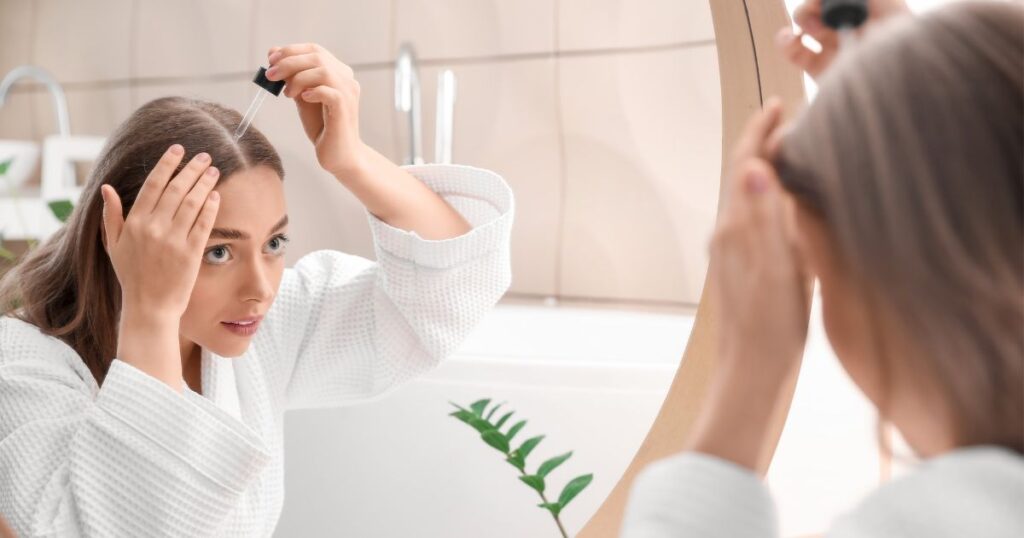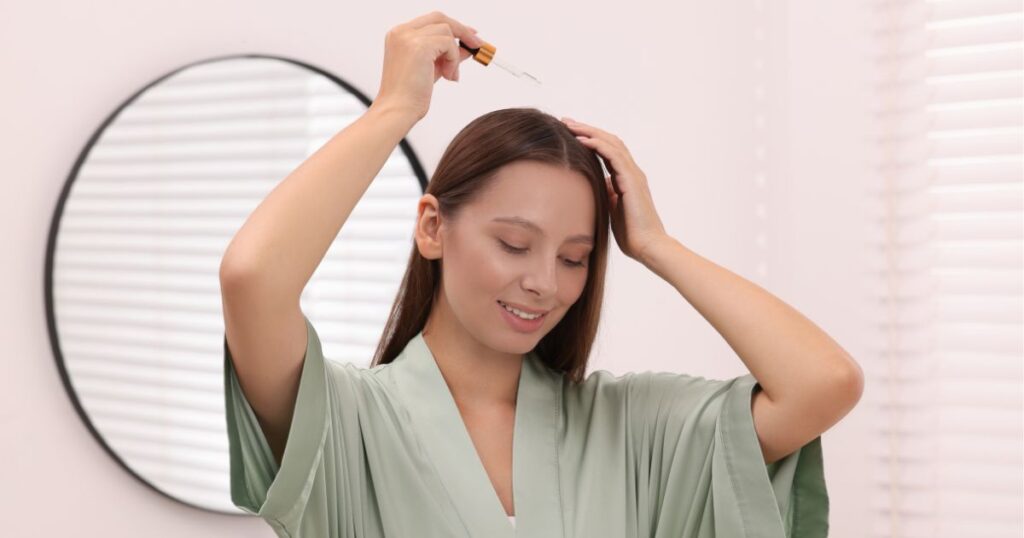Low porosity hair is a unique challenge in hair care, often misunderstood and mistreated with conventional products that don’t address its specific needs. This guide is your key to unlocking the secrets of low porosity hair, designed to help you:
- Understand what low porosity hair is
- Identify if you have low porosity hair
- Navigate the challenges it presents
- Choose the right clean beauty products and care strategies
Equipped with this knowledge, you’ll be ready to transform your hair care routine, ensuring your low porosity hair not only absorbs moisture more effectively but retains it, giving you healthy, vibrant, and resilient locks.
Table of Contents - Click to Go
What is Hair Porosity?
Hair porosity refers to your hair’s ability to absorb and retain moisture. It’s a critical factor that influences how well oils and moisture pass in and out of the outermost layer of your hair, known as the cuticle. Understanding your hair’s porosity can revolutionize your hair care routine, allowing you to select products and techniques that align perfectly with your hair’s unique needs.
How Do You Know if You Have Low Porosity Hair?
Low porosity hair has tightly bound cuticles with overlapping scales that lay flat. This characteristic makes it challenging for water, oils, and other moisturizing products to penetrate the hair shaft.
You might have low porosity hair if you notice:
- Products tend to sit on your hair rather than absorb
- Your hair takes a long time to dry
- Your hair is resistant to coloring or chemical treatments
- Water beads up on your hair
To confirm if you have low porosity hair, you can perform a simple test at home: drop a strand of clean hair into a glass of water. If it floats after a few minutes, you likely have low porosity hair, as it resists saturation.
Challenges of Low Porosity Hair

Managing low porosity hair comes with its set of challenges, primarily revolving around moisture absorption and retention.
These include:
- Difficulty moisturizing: Moisture and conditioning products often struggle to penetrate the hair shaft, leading to dryness.
- Product buildup: Since products don’t easily absorb, they can accumulate on the hair’s surface, weighing it down.
- Lack of elasticity: Without sufficient moisture, low porosity hair can become brittle and prone to breakage.
Challenges in Moisture Absorption
The primary hurdle with low porosity hair is its difficulty absorbing moisture. The closed cuticle structure causes water and hydrating products to remain on the surface. This leads to two main issues:
- Moisture creates a heavy or greasy feel on the hair.
- The hair remains dry and brittle, lacking the hydration it needs.
Hair Care Tips for Low Porosity Hair

Navigating the care for low porosity hair can be straightforward with the right approach. Here are some tailored tips to help your hair absorb and retain the moisture it needs.
Avoid Product Buildup
Another concern is product buildup. With products sitting on the hair rather than being absorbed, buildup is common. This results in:
- Limp and lifeless hair due to the weight of the buildup.
- A vicious cycle where buildup blocks further moisture absorption, exacerbating dryness.
Use Lightweight, Hydrating Products
For low porosity hair, the choice of products is crucial:
- Prefer water-based moisturizers and conditioners that are lightweight.
- Avoid products with heavy oils and butters to prevent buildup.
Incorporate Heat in Your Moisturizing Routine
Enhancing moisture absorption can be achieved with a bit of warmth:
- Utilize a steam cap or warm towel when conditioning to help open the cuticles.
- Use a hair dryer on a low setting, with protection, to assist product penetration.
Apply Products to Damp Hair
Moisture penetration is more effective on slightly wet hair:
- Mist hair lightly before applying products to ensure even distribution and better absorption.
- This method aids in preventing product from just sitting on the hair’s surface.
Regular Cleansing
To prevent buildup, cleansing with a clarifying shampoo is essential. However, it’s crucial to use clarifiers judiciously to prevent stripping hair of natural oils and maintain a balance to keep hair clean without drying it out.
Choose the Right Oils
Selecting appropriate oils can seal in moisture without the buildup:
- Opt for lighter oils like argan or grapeseed, which are more likely to penetrate the hair shaft.
- Apply these oils in moderation to lock in the moisture effectively.
Clarify Regularly
Keeping low porosity hair free from buildup is essential:
- Use a clarifying shampoo monthly to cleanse away residue.
- Follow with a deep conditioner to replenish any lost moisture.
Embrace Low Manipulation Styles
Protecting your hair from excessive handling helps retain moisture:
- Choose styles that require minimal touching and restyling, such as protective braids or twists.
- These styles help in reducing breakage and preserving moisture.
Deep Condition Regularly
A regular deep conditioning routine is vital for hydration:
- Deep condition every 2-4 weeks, choosing products specifically designed for low porosity hair.
- Incorporating heat during this process can greatly enhance moisture absorption.
DIY Hair Treatments and Remedies

Low porosity hair benefits greatly from treatments that encourage moisture penetration and retention. Here are effective DIY remedies to incorporate into your care routine.
Apple Cider Vinegar Rinse
An apple cider vinegar (ACV) rinse can help clarify your scalp and hair, removing buildup and slightly lifting the cuticles for better moisture absorption.
- Mix 1 part ACV with 3 parts water.
- After shampooing, apply the mixture to your hair and scalp.
- Leave it on for 2-3 minutes before rinsing thoroughly.
Honey Hair Mask
Honey is a natural humectant, which means it attracts moisture. A honey hair mask can hydrate your hair and add shine.
- Combine 2 tablespoons of raw honey with 1 cup of warm water until fully dissolved.
- Apply to damp hair, ensuring even coverage.
- Leave on for 30 minutes under a shower cap, then rinse with warm water.
Aloe Vera Leave-In Conditioner
Aloe vera is excellent for hydrating low porosity hair due to its lightweight and penetrating properties.
- Mix equal parts of aloe vera gel and water in a spray bottle.
- Add a few drops of a light oil like argan oil for extra nourishment.
- Shake well and spritz on damp hair as a leave-in conditioner.
Deep Conditioning Heat Cap Treatment
Using a DIY heat cap can enhance your deep conditioning sessions, allowing the product to penetrate more effectively.
- Apply your favorite deep conditioner to clean, damp hair.
- Cover your hair with a plastic cap, then wrap a warm, damp towel around your head.
- Leave on for 30-45 minutes before rinsing. You can also use a heated gel cap as an alternative.
Banana and Avocado Hair Mask
This nutrient-rich mask can help moisturize and strengthen low porosity hair, thanks to the natural oils and vitamins in bananas and avocados.
- Blend one ripe banana and one ripe avocado until smooth.
- Apply the mixture to your hair, from roots to ends.
- Leave on for 30 minutes under a shower cap, then rinse thoroughly with warm water.
How Diet and Lifestyle Affects Your Hair
The journey to healthy low porosity hair isn’t just about the right shampoos or conditioners; it’s also about what you put into your body. Diet and lifestyle choices significantly affect hair health. Here’s how you can support your hair from the inside out.
Stay Hydrated
Hydration is key for healthy hair.
- Aim to drink plenty of water every day.
- Eat water-rich fruits and vegetables like cucumbers and berries to help hydrate your hair from within.
Boost Your Protein
Protein is crucial for hair strength.
- Include lean proteins such as fish, tofu, and nuts in your diet.
- Snack on protein-rich foods like Greek yogurt to support hair health.
Incorporate Healthy Fats
Healthy fats add shine and support scalp health.
- Omega-3 sources like salmon and chia seeds are great for your hair.
- Use olive oil and avocados for cooking to get those beneficial fats.
Get Enough Vitamins and Minerals
Certain nutrients are essential for hair growth and health.
- Vitamin E found in almonds and spinach supports hair growth.
- Iron in lentils and spinach helps oxygenate your hair follicles.
- Zinc, available in pumpkin seeds, combats hair loss.
Manage Stress
Stress can negatively impact your hair.
- Engage in stress-reduction activities such as yoga or meditation.
- Make sure to get enough sleep for overall health and hair recovery.
Limit Heat and Chemicals
Your daily hair care practices matter.
- Reduce the use of heat styling tools to prevent damage.
- Opt for natural styling techniques and steer clear of harsh chemicals.
Keep Your Hair Healthy By Improving Your Low Porosity Hair

Caring for low porosity hair is a journey of discovery and adaptation. This guide has armed you with the essentials—from understanding this unique hair type to selecting the right products and embracing natural treatments. Remember, the journey is as much about nurturing from within as it is about external care.
Key Takeaways:
- Understanding Porosity Is Crucial: Identifying your hair as low porosity is the first step toward tailored care, focusing on its need for moisture penetration and retention.
- Product Selection: Opt for lightweight, water-based products that won’t weigh down low porosity hair and avoid heavy oils and butters which can lead to buildup.
- Incorporate Heat: Using mild heat during conditioning treatments can help open up the cuticles, allowing for better absorption of moisture and nutrients.
- DIY Remedies Work Wonders: Natural, homemade treatments like apple cider vinegar rinses or honey masks can effectively address low porosity hair’s moisture needs without the harsh chemicals.
- Diet and Lifestyle Matter: A balanced diet rich in proteins, vitamins, and minerals, along with adequate hydration and stress management, supports healthy hair growth and maintenance from the inside out.
- Patience and Consistency: Adapting to a routine that caters to low porosity hair’s specific needs is key, emphasizing the importance of regular care and adjustment based on how your hair responds.

